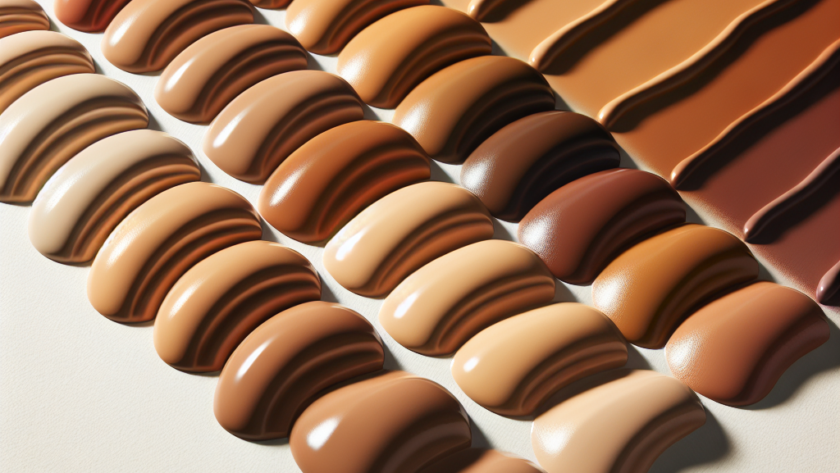Choosing the right foundation shade can sometimes feel like a daunting task, but fear not! With a few simple tips and tricks, you’ll be well on your way to finding your perfect match. From determining your undertone to testing shades on your jawline, this article will guide you through the process step by step. So say goodbye to the days of mismatched foundation and hello to a flawless complexion!
Understanding Your Skin Undertone
Understanding your skin undertone is essential when it comes to finding the perfect foundation shade. Your undertone is the underlying color that influences how your skin looks and reacts to different colors. There are three main undertones: warm, cool, and neutral. By determining your undertone, you can narrow down your options and find a foundation that will enhance your natural beauty.
Warm Undertones
If you have warm undertones, your skin has a yellow or golden hue. You may also have peachy or apricot undertones. Warm undertones are often characterized by veins that appear more green than blue. People with warm undertones tend to look best in warm, earthy colors such as oranges, browns, and golds.
Cool Undertones
Cool undertones are characterized by a pink or bluish hue to the skin. Veins tend to appear more blue than green. If you have cool undertones, you may find that you look best in jewel tones such as deep purples, blues, and emerald greens. Cool undertones can also be accompanied by rosy cheeks.
Neutral Undertones
If you have a neutral undertone, your skin has a mix of warm and cool tones. Your veins may appear to be a mix of blue and green, and you can pull off both warm and cool colors. Neutral undertones are versatile and can wear a wide range of foundation shades.
Determining Your Skin Undertone
Now that you understand the different undertones, it’s time to determine your own. There are a few tests you can do at home to help you figure out whether you have warm, cool, or neutral undertones.
The Vein Test
Look at the veins on your wrist or the inside of your arm. If they appear more green, you likely have warm undertones. If they appear more blue, you likely have cool undertones. If you can’t quite tell or see a mix of both, you may have a neutral undertone.
The Jewelry Test
Try on gold and silver jewelry to see which metal complements your skin tone better. If gold looks better on you, chances are you have warm undertones. If silver looks better, you likely have cool undertones. If both metals look equally good, you may have a neutral undertone.
The Sun Tan Test
Observe how your skin reacts to the sun. If you tan easily and rarely get sunburned, you likely have warm undertones. Cool undertones tend to burn easily and may not tan as much. If you tan somewhat but also experience some sunburn, you may have a neutral undertone.
Identifying Your Skin Tone
Once you have determined your undertone, it’s important to identify your specific skin tone. There are several broad categories that can help guide you in choosing the right foundation shade for your complexion.
Fair Skin Tone
Fair skin tones are typically the lightest shades. Usually, fair skin lacks pigmentation and tends to burn more easily than it tans. If you have fair skin, you may often struggle with finding foundations that don’t appear too dark or too orange on your complexion.
Light Skin Tone
Light skin tones often have a subtle hint of warmth or coolness, depending on the undertone. This skin tone can range from having a porcelain-like appearance to a slightly sun-kissed look. Many foundation shades are available for light skin tones, making it easier to find a suitable match.
Medium Skin Tone
Medium skin tones have more pigment and can appear as a golden or olive complexion. This skin tone often has a healthy glow and can handle a wider range of foundation shades. People with medium skin tones may still need to be mindful of finding the right undertone to avoid a mismatched foundation shade.
Olive Skin Tone
Olive skin tones have a unique mix of warm and cool undertones, often with a slight green or gray hue. This skin tone can range from light to medium-dark and can handle many different foundation options. Olive skin tones often look best in foundation shades with yellow or green undertones.
Deep Skin Tone
Deep skin tones range from medium-dark to very dark and have a rich, melanin-rich complexion. These complexions can have warm, cool, or neutral undertones. Deep skin tones may struggle to find foundation shades that cater to their specific undertones, but there is an increasing range of options available.
Matching Foundation to Your Undertone and Skin Tone
Once you have identified your undertone and skin tone, it’s time to find a foundation that matches perfectly. Here are some tips for matching foundation to your specific combination of undertone and skin tone.
Cool Undertone with Fair Skin Tone
If you have a cool undertone with fair skin, look for foundation shades with pink or neutral undertones. Avoid foundations that have too much yellow or golden tones, as they can make your skin appear sallow.
Warm Undertone with Light Skin Tone
For those with a warm undertone and light skin, opt for foundation shades with yellow or golden undertones. Avoid foundation shades that are too cool or pink, as they can clash with your warmer complexion.
Neutral Undertone with Medium Skin Tone
If you have a neutral undertone with a medium skin tone, consider yourself lucky. You can wear a wide range of foundation shades that have both warm and cool undertones. Experiment with different shades and find the one that best enhances your natural complexion.
Olive Skin Tone with Neutral Undertone
Olive skin tones with a neutral undertone should look for foundation shades that have a yellow or greenish undertone. These shades will complement your unique complexion and enhance your natural beauty.
Deep Skin Tone with Cool Undertone
For those with a deep skin tone and cool undertones, seek out foundation shades with deep, rich undertones that have blue or pinkish hues. Avoid foundations that are too light or have yellow undertones, as they can appear ashy on your complexion.
Understanding Foundation Formulations
In addition to finding the right shade for your undertone and skin tone, it’s important to understand different foundation formulations. The type of formulation you choose will depend on your skin type, desired coverage, and personal preference.
Liquid Foundations
Liquid foundations are the most common type of foundation and offer a versatile range of coverage options. They can provide sheer to full coverage, depending on the formula and how you apply it. Liquid foundations generally work well for all skin types but can be especially beneficial for dry or mature skin.
Cream Foundations
Cream foundations have a thicker consistency and provide medium to full coverage. They are ideal for those who want a more flawless finish and need extra coverage for blemishes or imperfections. Cream foundations are often recommended for those with normal to dry skin.
Powder Foundations
Powder foundations come in pressed or loose form and provide a more natural, lightweight coverage. They are great for oily or combination skin types as they help absorb excess oil. Powder foundations are also convenient for touch-ups throughout the day.
Stick Foundations
Stick foundations are in a solid form and are ideal for those who prefer a convenient, portable option. They offer buildable coverage and can be used for spot-concealing or all-over application. Stick foundations are suitable for all skin types, depending on the specific formulation.
Choosing the Right Foundation Coverage
When selecting a foundation, it’s important to consider the level of coverage you desire. Coverage refers to how much the foundation can hide imperfections and even out your skin tone.
Sheer Coverage
Sheer coverage foundations offer a lightweight, natural finish. They allow your skin to shine through while providing a subtle evening out of the complexion. Sheer coverage foundations are great for those who want a minimal or “no-makeup” look or for everyday wear.
Light Coverage
Light coverage foundations provide a touch more coverage than sheer formulas. They blur imperfections while still allowing your natural skin to show through. Light coverage foundations are suitable for those with minor blemishes or those who prefer a more natural-looking finish.
Medium Coverage
Medium coverage foundations even out the skin tone and cover mild imperfections, such as redness or light acne scars. They offer a balance between coverage and a natural finish, making them suitable for everyday wear or when you want to achieve a more polished look.
Full Coverage
Full coverage foundations provide maximum coverage and are ideal for those with severe acne, hyperpigmentation, or scarring. They mask imperfections and create a flawless base. Full coverage foundations are often used for special occasions or when you want a more glamorous, perfected appearance.
Testing Foundation Shades
Now that you know your undertone, skin tone, and desired coverage, it’s time to test different foundation shades to find the perfect match. Here are some methods for testing foundation shades effectively.
Testing on Your Jawline
Apply a few different shades of foundation to your jawline, blending them in well. The shade that seamlessly blends into your natural skin tone is the closest match. Avoid testing on your wrist or hand, as those areas may not accurately represent your face.
Testing on Your Forehead
Apply a small amount of foundation to your forehead and blend it out. Assess how well the shade matches and consider how it looks in different lighting conditions. Your forehead can often be a good indicator of whether the shade is a suitable match for your overall complexion.
Testing in Natural Light
Natural light is the best way to assess how well a foundation shade matches your skin. Step outside and observe your reflection in a mirror or take a selfie. Natural light provides the most accurate representation of how the foundation will look in different lighting environments.
Considering the Season and Lighting
It’s essential to consider the season and lighting conditions when choosing a foundation shade. Your skin tone may change slightly throughout the year due to factors like sun exposure and tanning. Experiment with different shades or have multiple foundations that cater to your changing skin tone.
Adapting to Seasonal Changes
During the summer months, when your skin tends to be darker due to increased sun exposure, you may need a slightly deeper shade of foundation. In winter, when your skin may be paler due to limited sun exposure, a lighter shade may be necessary. Adjust your foundation shade accordingly to avoid any noticeable lines of demarcation.
Considering Different Lighting
Different lighting conditions can affect how your foundation shade appears on your skin. Lighting can either enhance or disguise the true color of your foundation. Be sure to check your foundation shade in various types of lighting, such as natural light, fluorescent light, and incandescent light, to ensure it looks natural and flattering in all settings.
Seeking Professional Assistance
If you’re still unsure about finding the right foundation shade or want expert advice, seeking professional assistance is a great option. There are two primary ways to get professional help in finding your perfect match.
Consulting a Makeup Artist
Makeup artists are trained to match foundation shades and can provide personalized recommendations based on your skin undertone, skin tone, and desired coverage. They can help narrow down your options and suggest the best formulas and brands for your individual needs.
Getting a Professional Color Match
Many beauty retailers offer professional color-matching services. These services use innovative technology to analyze your skin tone and find the perfect foundation shade. Beauty consultants will assist you in finding the ideal match and may provide samples or swatches for you to try at home.
Taking Care of Your Skin
Choosing the right foundation shade is just one part of achieving a flawless complexion. Taking care of your skin is equally important in ensuring that your foundation looks its best.
Proper Skincare Routine
Start by establishing a skincare routine that works for your skin type and concerns. Cleanse, tone, and moisturize your skin daily to keep it healthy and hydrated. Use products that address your specific concerns, such as acne, dryness, or aging.
Prepping Your Skin for Foundation
Before applying foundation, make sure your skin is clean and moisturized. Use a primer to create a smooth base and help your foundation last longer. Applying a primer also helps to minimize the appearance of pores and fine lines. Choose a primer that suits your skin type, such as a mattifying primer for oily skin or a hydrating primer for dry skin.
In conclusion, understanding your skin undertone and finding the right foundation shade is a crucial step in achieving a flawless complexion. By identifying your undertone and skin tone, testing different shades, and considering factors such as coverage, formulation, and lighting conditions, you can confidently choose a foundation that enhances your natural beauty. Don’t be afraid to seek professional assistance if needed, and remember to take care of your skin to ensure that your foundation looks its best.



